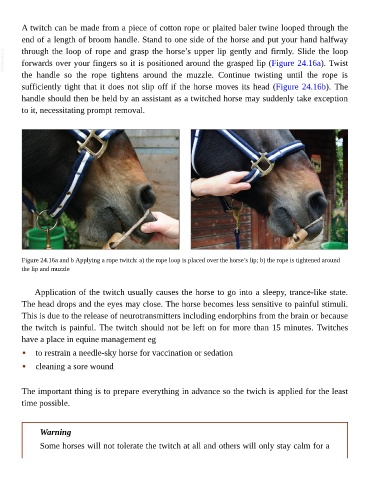Page 1082 - The Veterinary Care of the Horse
P. 1082
A twitch can be made from a piece of cotton rope or plaited baler twine looped through the
end of a length of broom handle. Stand to one side of the horse and put your hand halfway
VetBooks.ir through the loop of rope and grasp the horse’s upper lip gently and firmly. Slide the loop
forwards over your fingers so it is positioned around the grasped lip (Figure 24.16a). Twist
the handle so the rope tightens around the muzzle. Continue twisting until the rope is
sufficiently tight that it does not slip off if the horse moves its head (Figure 24.16b). The
handle should then be held by an assistant as a twitched horse may suddenly take exception
to it, necessitating prompt removal.
Figure 24.16a and b Applying a rope twitch: a) the rope loop is placed over the horse’s lip; b) the rope is tightened around
the lip and muzzle
Application of the twitch usually causes the horse to go into a sleepy, trance-like state.
The head drops and the eyes may close. The horse becomes less sensitive to painful stimuli.
This is due to the release of neurotransmitters including endorphins from the brain or because
the twitch is painful. The twitch should not be left on for more than 15 minutes. Twitches
have a place in equine management eg
• to restrain a needle-sky horse for vaccination or sedation
• cleaning a sore wound
The important thing is to prepare everything in advance so the twich is applied for the least
time possible.
Warning
Some horses will not tolerate the twitch at all and others will only stay calm for a

